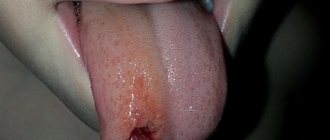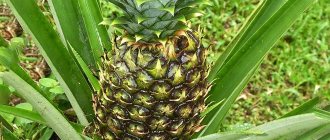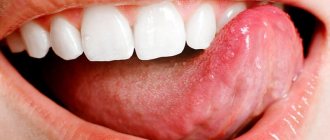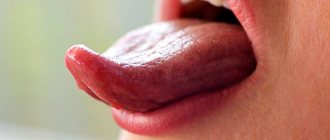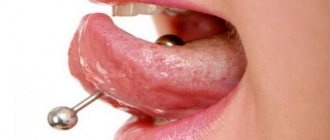Language is a kind of indicator of health status. Some changes in the color, shape, and structure of the taste organ may indicate specific internal pathologies, so you need to pay attention to its appearance.
For example, a raspberry tongue can be a symptom of diseases such as scarlet fever, Kawasaki syndrome, chickenpox, measles . But it can also indicate less obvious pathologies: renal failure, vitamin deficiency. A complete list of diseases that can cause the tongue to turn red, and methods to combat them are listed in the article.
What does a healthy tongue look like?
First, let's remind parents what a healthy tongue looks like. The following signs indicate the state of normality:
- the size is not increased;
- humidity is moderate;
- the color of the tongue is pale pink, without spots or grooves;
- sensitivity is normal, papillae are not enlarged;
- allow for a light coating that is easy to clean;
- There is no bad breath.
If, upon examination of the child, the condition of his tongue corresponds to the signs described above, there is no reason to worry and see a doctor.
Tongue peels during pregnancy
You're pregnant and your tongue is peeling. What could be the problem? Below is how you can solve this problem.
While pregnant, some women sometimes develop a “blue tongue.” This staining may intensify after a while, and the tongue begins to peel off. This condition can develop due to nutritional deficiencies. In this case, it is necessary to urgently undergo a dental examination. Also, the problem of “blue tongue” can be associated with bloating, sleep disturbances, probably due to anxiety and certain eating habits.
Additionally, tongue peeling during pregnancy can sometimes occur due to an imbalance in thyroid hormone levels. If this is the case, then you need to seek help from an endocrinologist.
It is also important to note that some of the reasons that have already been discussed above can lead to peeling of the tongue mucosa during pregnancy.
Changes that should alert parents
In addition to changes in the color of the taste organ, parents should be wary of other accompanying symptoms, including:
- swelling, against which the imprints of teeth can be seen;
- insufficient moisture or obvious dryness of the surface of the tongue;
- enlarged papillae, especially pronounced in the root part;
- formation of persistent plaque on the surface of the tongue;
- burning sensation and impaired taste perception;
- the appearance of a specific odor from the mouth.
Parents can notice these changes during a visual inspection, which is best done in the morning in natural light. If the situation continues for a long time, the plaque thickens and the color of the tongue does not return to normal, there is every reason to consult a doctor to find out the reasons and identify hidden pathology.
Secondary medical education
- General midwife
- Dental assistant
- Dentist
- Dentist
- Dental Technician
- General expert research laboratory assistant
- Blood service laboratory technician
- AIDS service laboratory technician
- Laboratory assistant of forensic biological departments
- Laboratory assistant of forensic histology departments
- Laboratory assistant of physical and technical departments
- Laboratory assistant at chemical and toxicological departments
- Gynecological nurse
- Neonatology nurse
- General practice nurse
- Nurse of the intensive care and anesthesiology departments
- Ophthalmic nurse
- Pediatric nurse
- Physical therapy nurse
- Nutritional Nurse
- Massage nurse
- Care nurse
- Healthy lifestyle nurse
- Tuberculosis service nurse
- Psychoneurological nurse
- Blood service nurse
- AIDS service nurse
- Dental nurse
- Therapeutic nurse
- Physiotherapeutic nurse
- Surgical nurse
- Medical statistician
- Laboratory assistant doctor
- Nurse's assistant
- X-ray technician
- Paramedic laboratory assistant
- Narcology paramedic
- General practitioner
- Paramedic of the public education system
A red or pale tongue is not the norm!
Both options indicate pathological changes occurring in the child’s body:
- A crimson-red tongue always indicates the presence of an infection (viral, bacterial or fungal). Most often it is tonsillitis, scarlet fever, stomatitis or glossitis.
- A red and shiny tongue is a sign of anemia, exhaustion and severe stomach disease;
- A cherry tint is a sign of influenza and measles, as well as general intoxication or kidney dysfunction;
- A bluish color indicates a lack of oxygen; there is reason to suspect disorders in the cardiovascular system or lungs;
- Purple color may indicate blood and lung diseases, heart failure.
- A too pale tongue, being penetrated by blood vessels, a priori cannot be lighter than blood. In most cases, this sign indicates exhaustion, deficiency of folic acid or vitamin B 12.
Let us remind parents that very often there may be a coating on the surface of the tongue, the color of which also has its own characteristics.
Anemia
Anemia, also called anemia, is characterized by a low concentration of hemoglobin in the blood, and its different types differ in color, severity and other characteristics. One of the varieties is B12 deficiency anemia, also called Addison-Birmer disease, a feature of which is a lack of vitamin B12 in the body, which is necessary for the normal functioning of the bone marrow and central nervous system.
A red tongue is one of the symptoms of anemia.
Frequent accompaniments of this disease are neurological disorders: numbness of the limbs and ataxia due to the death of nerve cells. A red tongue is also one of the symptoms of this type of anemia, and as the disease progresses, it takes on a “varnished” appearance caused by damage to its surface.
Additional Information . In addition to the obvious cause of the disease in the form of a lack of vitamin B12 in the diet, the development of this anemia is influenced by some disorders and diseases of the gastrointestinal tract (including helminths and cancer), as well as heredity.
Causes of tongue redness
All existing causes of external changes in the language, including its color, can be divided into two groups. The first group of factors are easily solvable problems that do not signal internal disorders and are not a cause for concern on the part of parents. These include:
- consumption of coloring foods and drinks,
- eating too hot (cold) food;
- mechanical trauma from a brush, teeth, lollipop, etc.
The second one combines negative causes that are inextricably linked with pathological processes that are hidden or obvious in the child’s body:
- inflammation of the taste buds;
- any inflammatory processes caused by viruses or infection;
- intoxication of the body due to poisoning;
- taking medications (antibiotics);
- allergic reaction to food, medications.
- lack of vitamins and microelements.
Only a doctor can identify the true cause of changes in the color and texture of the tongue. Parents should not engage in self-diagnosis and self-medication; this will only mask the problem and complicate the doctor’s work.
Causes of red plaque on the tongue
Among the reasons leading to the formation of red deposits on the tongue are the following:
- When the tongue is very red and a coating forms over its entire surface, a significant increase in body temperature and even fever can be suspected.
- When the tongue becomes red, but the consistency of the plaque remains dry, the cause of this condition may be inflammation of the brain substance or its membranes. The same condition is caused by inflammatory processes occurring in the intestines, stomach and lungs.
- When the tongue turns red and shines, this indicates that the person’s body temperature has reached critical values.
- When the plaque turns crimson in color, severe infections can be suspected, in particular scarlet fever and tonsillitis. With scarlet fever, the papillae of the tongue additionally protrude above its surface. Pneumonia is another reason for a raspberry-colored tongue.
- The plaque turns dark red in color when a person suffers from kidney infections. The same thing occurs when the body is poisoned by various toxic substances.
- A burgundy coating may signal the development of influenza or measles.
- If a red coating is localized on the tip of the tongue, this may indicate diseases of the rectum or sigmoid colon, uterus or bladder. That is, organs located in the pelvic region.
- The appearance of a red plaque, unevenly distributed, may be evidence of an allergy. This type of language can be observed especially often in childhood.
- Eating food containing dyes can turn the existing coating on the tongue red.
- Injuries to the tongue cause it to turn red. This could be organ bites, mechanical damage caused by candies or other foreign objects.
- A tongue burn, both chemical and thermal, will inevitably lead to reddening of the plaque on the tongue and the organ itself as a whole.
- If red spots form on the tongue, with a blue coating on top, then the person may develop Kaposi's sarcoma.
- Anemia is another reason for the appearance of plaque on the tongue; the organ becomes unnaturally pale.
- Multiple tartar and advanced caries can cause red deposits to form on the tongue.
- Bad habits are an equally common cause of red plaque.
- Infection of a person with parasites can cause the tongue to become covered with a red coating.
- Glossitis, occurring in any form, can lead to the formation of red patches.
What diseases does a red tongue hide?
A red tongue can be a symptom of diseases of various etiologies, including:
- angina;
- flu;
- chickenpox,
- scarlet fever;
- stomatitis;
- glossitis;
- pneumonia;
- Kawasaki disease;
- gastritis;
- severe poisoning;
- renal failure;
- vitamin deficiency (vitamin B deficiency).
As you can see, the list of diseases is quite wide and requires visiting not only an otolaryngologist, but also, if necessary, other specialized specialists: dentist, endocrinologist, gastroenterologist, etc.
Condition of the mucous membrane of the tongue
Changes in the condition of the mucous membrane of the tongue are an indicator of pathogenic processes in the body, and therefore in medicine the characteristics of the tongue are used to diagnose diseases.
An excessively dry surface of the mucous membrane of the tongue indicates, first of all, dehydration. It can also be caused by peritonitis, intestinal obstruction, hyperthermia in infectious diseases, as well as a long stay in a coma. With prolonged constant dryness, the appearance of cracks in the tongue is possible. A dry tongue with numerous cracks is also characteristic of diabetes mellitus, and if left untreated in a diabetic coma, the speech organ becomes brownish-brown.
Under the influence of what factors do tongue diseases develop?
Tongue diseases can occur in humans due to many factors:
- Pathogenic fungi, viruses and bacteria that accumulate in dental plaque or enter the body through the “gate of infection” - the oral cavity.
- Injuries caused to teeth by careless chewing of food, spicy and hard foods, uncomfortable dentures, or a splintered tooth.
- Contact with food allergens.
- Vitamin deficiency or lack of elements necessary to maintain healthy tongue tissue.
- Dehydration due to illness or improper drinking regimen.
- Unhealthy lifestyle with bad habits.
- Metabolic disorders in the body.
- Blood supply defects.
- Nervous regulation disorder.
- Neoplasms.
- Congenital developmental anomalies.
- Accumulation of toxins and metabolic products in tissues due to kidney or liver dysfunction.
- Inflammatory diseases in the digestive and respiratory organs.
- Development of dysbacteriosis.
Symptoms for various diseases
Red spots on the tongue are a symptom indicating a certain disease. It is possible to identify the type of pathology by assessing the patient’s condition and identifying other characteristic phenomena.
Scarlet fever
Mostly children suffer from scarlet fever, but there is a risk of streptococcal infection in adults. The pathology is accompanied by the following symptoms:
- formation of small rashes on the mucous membrane;
- pain in the throat;
- increased temperature ;
- the formation of a white coating on the middle part of the tongue;
- redness of the tongue.
Treatment for scarlet fever takes about 10 days.
Mononucleosis
Mononucleosis is a viral disease in which approximately 70% of patients develop pinpoint hemorrhages on the surface of the tongue. The pathology is characterized by:
- elevated temperature;
- general weakness;
- enlarged lymph nodes;
- the appearance of pain when swallowing;
- feverish condition.
Mononucleosis causes changes in blood composition, which is one of the main diagnostic indicators.
Stomatitis
Stomatitis is a dental pathology accompanied by the appearance of characteristic ulcers or aphthae on the surface of the mucous membrane in the oral cavity. The latter are covered with a white coating. When treating the oral cavity, the patient experiences pain.
The tongue with scarlet fever has a characteristic appearance - it is bright crimson, shiny and smooth. The taste buds are smoothed out. This is the main diagnostic sign of the disease.
Dentist
Novikova Olga Alexandrovna
8 years of experience
Erythema
Erythema migrans occurs rarely. With this disease, red spots with an uneven edge appear on the surface of the tongue. Researchers believe that the pathology develops against the background of a viral or infectious lesion of the body. There are no other symptoms of this disease.
Depending on the location, a red spot on the tongue may indicate diseases of the lungs, kidneys, heart, stomach, gallbladder, liver, intestines, and spleen.
Antifungal drugs, immunomodulators, vitamin complexes, and rinsing with antiseptics will help eliminate the stain.
The exudative form of erythema is characterized by rapid development. The first symptoms appear during the first day. This form of erythema is characterized by:
- increase in temperature;
- sore throat;
- constant headaches ;
- the formation of red spots on the surface of the tongue, which over time transform into blisters.
The blisters, filled with serous fluid, self-open after a few days. In their place, erosion occurs. Because of the wounds that occur on the tongue, speech deteriorates and eating becomes more difficult.
Kawasaki syndrome
Kawasaki syndrome is rare. It appears as bright crimson spots that form on the surface of the tongue. Along the way, the patient experiences:
- increase ;
- swelling of the lips;
- conjunctivitis;
- skin rash.
Simultaneously with the formation of characteristic spots, the skin on the fingers begins to peel off.
Syphilis
Syphilis is a sexually transmitted sexually transmitted disease. It is characterized by the appearance of red spots of a dense structure on the surface of the tongue. The diameter of the latter does not exceed 2 cm. The spots themselves do not hurt when pressed. Syphilis in the initial stages of development is usually asymptomatic.
Shingles
At the initial stage, shingles manifests itself in the form of high fever and severe soreness of the tongue in the place where the red spot appears. The latter is mainly formed at the end and at the root of the organ.
Why can our articles be trusted?
We make health information clear, accessible and relevant.
- All articles are checked by practicing doctors.
- We take scientific literature and the latest research as a basis.
- We publish detailed articles that answer all questions.
As the disease develops, vesicles filled with serous fluid appear in place of the red spots. Self-opening, they leave behind areas of erosion.
Kaposi's sarcoma
Kaposi's sarcoma is a malignant neoplasm. It is more often diagnosed in people with HIV infection. The disease is characterized by the appearance of red spots at the root of the tongue that have a bluish tint. In some cases, when pressing on the affected area, pain occurs.
Also, red spots on the tongue occur with candidiasis and anemia. In the first case, the clinical picture is complemented by itching, which is localized on the surface of the affected organ. With anemia, the tongue becomes white except for small areas of redness.


